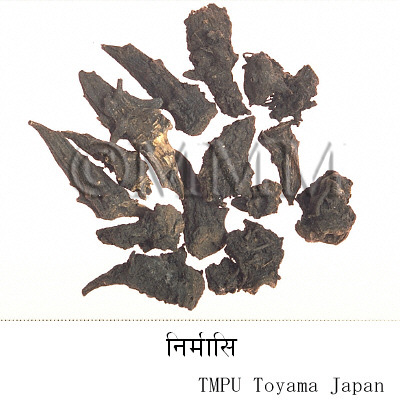Crude drug sample data base
※Click on the image to enlarge it.
Crude drug name | Market name | Nirmasi |
|---|---|---|
| Formal name | Vatsanabha | |
Other names Tips! | Mohri (H) | |
| English name | Indian Napellus | |
| Original plant name | Aconitum chasmanthum Stapf ex Holmes, Indian Napellus | |
| Family name | Ranunculaceae | |
| Used part | Classification | Plant origin | Sub classification | root |
| Collection information | Kingdom of Nepal, Kathmandu | |
| Collection date | 1991/04/13 | |
| Collector | Tsuneo Namba, et al. | |
| TMPW No. | 14799 | |
The capital city, provincial capital city or the representative
location of its administrative area is indicated.
location of its administrative area is indicated.
Production area information
https://ethmed.toyama-wakan.net/img/pin_san.png
27.7172453
85.3239605
Collection information
Kingdom of Nepal,Kathmandu
https://ethmed.toyama-wakan.net/img/pin_nyu.png
Scientific information data base
| Crude drug name | Ayurvedic name or Sanskrit name, English name | Vatsanabha (A. chasmanthum), Indian Napellus | ||
|---|---|---|---|---|
| Synonyms | Amrta, Vajraranga, Vatsanagaka, Visa, Sthavaravisa. | |||
| crude drug image |
| |||
| Original plant name | Aconitum chasmanthum Stapf ex Holmes | |||
| Family name | Ranunculaceae | |||
| Used part | Roots | |||
| Distribution area | An erect, perennial herb found in the sub-alpine and alpine western Himalayas between altitudes of 2100m and 3600 m; also found in the mountains of Assam and in the sub-alpine grasslands of Himachal Pradesh. | |||
| Common uses | Vatsanabha is a virulent poison but when mitigated, it works as alternative antiinflammatory, diaphoretic, expectorant, stomachic and nervine tonic. It is employed in large number of drug formulations prescribed for the cure of asthma, diabetes, loss of appetite, paralysis, rheumatic arthritis, typhoid and nasal catarrah. | |||
| Chemical constituent | Alkaloids 14-O-Benzoyl-8-methoxybikhaconine[(1alpha,6alpha,14alpha,16beta)-20-ethyl-13-hydroxy-1,6,8,16-tetramethoxy-4-methoxymethylaconitan-14-yl benzoate] (*C1), 14-O-Benzoyl-8-ethoxybikhaconine [(1alpha,6alpha,14alpha,16beta)-8-ethoxy-20-ethyl-13-hydroxy-1,6,16-trimethoxy-4-methoxymethylaconitan-14-yl benzoate] (*C1), Chasmanthinine (*C2), Indaconitine hemiactonitrile solvate (*C3) Others The alkaloid content of the roots ranges from 2.98 to 3.11 per cent. The following alkaloids have been isolated: indaconitine, chasmaconitine, chasmanthinine, chasmanine and homochasmanine. | |||
| Medical system | Ayurveda (Traditional Indian medicine) | |||
| Formulation | Mrtunjaya rasa, Hingulesvara rasa, Agnitundi vati, Sanjivani vati, Kaphaketu, Ananda bhairava, Jvaramurari, Tribhuvan kirti rasa and Laghu visa garva taila. | |||
| Related drugs | This species is very similar to A. napellus, for which it has often been mistaken. A. chasmanthum has the same uses as A. napellus (= A. ferox). | |||
| Comments | In some books, this species is also considered as Vatsanabha. | |||
| References | Reference book Tips! | Illustrated Manual of Herbal Drugs Used in Ayurveda, 1996. Sarin, Y.K., Council of Scientific & Industrial Research and Indian Council of Medical Research, New Delhi p 112. Plants in Ayurveda (A Compendium of Botanical and Sanskrit Names), 1997. Abdul Kareem, M., Foundation for Revitalisation of Local Health Traditions, Bangalore 3. | ||
| Research paper | *C1 Parvez, M., Gul, W. and Anwar, S.; Acta Crystallogr., Sect. C: Cryst. Struct. Commun., C54, 790-92 (1998). *C2 Parvez, M., Gul, W., Anwar, S., Miana, G. A., Atra-Ur-Rahman and Choudhry, M. I.; Acta Crystallogr., Sect. C: Cryst. Struct. Commun., C55, 70-72 (1999). | |||
| Remarks | Of the Acontinum spp. occurring in India, the roots of nine species are commonly found in the Indian markets. Chemical analysis of the market samples, obtained from various places, has shown that the aconite sold in Indian markets (commonly referred to as Acontinum ferox) is not a single species, but a mixture of three or four species with their alkaloid contents varying from 0.63 to 4.7 per cent. The material coming from Nepal consists of root of A. falconeri Stapf or a mixture of A. falconeri, A. laciniatum Stapf and A. ferox Wall. and A. spicatum Stapf. | |||
| Last renewal date | 2024/04/09 | |||

